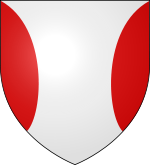
Flaunch
Encyclopedia

Heraldry
Heraldry is the profession, study, or art of creating, granting, and blazoning arms and ruling on questions of rank or protocol, as exercised by an officer of arms. Heraldry comes from Anglo-Norman herald, from the Germanic compound harja-waldaz, "army commander"...
, flaunches or flanches or flanks are among the ordinaries
Ordinary (heraldry)
In heraldry, an ordinary is a simple geometrical figure, bounded by straight lines and running from side to side or top to bottom of the shield. There are also some geometric charges known as subordinaries, which have been given lesser status by some heraldic writers, though most have been in use...
or subordinaries, consisting of two arcs of circles protruding into the field
Field (heraldry)
In heraldry, the background of the shield is called the field. The field is usually composed of one or more tinctures or furs. The field may be divided or may consist of a variegated pattern....
from the sides of the shield. The flaunch is never borne singly.
Plain flaunches are seen in the coats of Hulbert Paul Lindahl Silver and Gillian Patricia Birtwhistle. They may be of different tinctures
Tincture (heraldry)
In heraldry, tinctures are the colours used to emblazon a coat of arms. These can be divided into several categories including light tinctures called metals, dark tinctures called colours, nonstandard colours called stains, furs, and "proper". A charge tinctured proper is coloured as it would be...
, as in the coat of the Free State Women’s Agricultural Union (South Africa) where they are orange/tenny and azure.
Flaunches may touch each other, as in the coat of Bradley Hook.
Like any ordinary, they may
- be charged with other things, as in the English coats of Harlow District Council and Forest of Dean District Council.
- have colourings other than plain ones, as in the English coat of Hoylake Urban District Council and the Canadian one of the Central Saanich (British Columbia) Police Service.
- have ornamented edges, as in the Welsh coat of Maesteg Town Council.
A very rare variation is square flaunches, as in the coat of Sheila-Marie Suzanne Cook and the coat of the US Coastguard Cutter Sequoia. Parker's glossary, s.v. Flaunches, cites two similar coats for Mosylton or Moselton with square flaunches.

